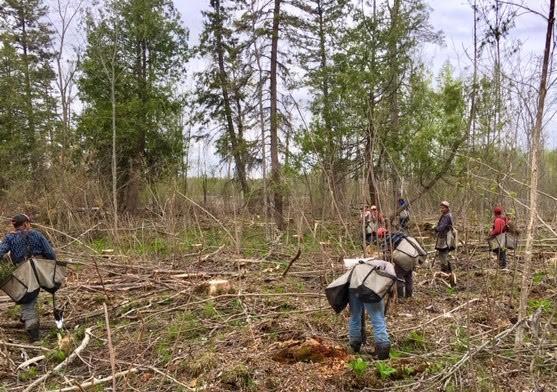Overview
We seek to diversify the stand composition by harvesting ash trees and regenerating the site with non-ash species due to what seems to be the inevitable infestation and death of ash trees due to EAB. Following timber harvest the site was planted with 12 native tree species considered to have a good chance at survival and recruitment in wet forest conditions. Tree species include red maple, white spruce, black spruce, tamarack, balsam fir, paper birch, bur oak, quaking aspen, hackberry, silver maple, swamp white oak and cottonwood.
Silviculture Objective(s)
- Implement a regeneration harvest prior to EAB infestation and ash mortality.
- Plant a variety of economically and ecologically appropriate replacement species.
- Introduce a few species not historically present in the WFn55 NPC.
- Monitor growth and survival to determine which species may be best suited to replace ash on wet forest sites.
- Observe species recruitment as conditions become warmer and wetter over time due to climate change.
Pre-treatment stand description and condition
Stand establishment and management history:
This ash stand established through natural stand regeneration processes over the last hundred years. As a keystone species in wet forest systems, ash is the dominant tree species in the stand. However, other suitable tree species have established over the years adding to the diversity of the stand. Our observations and professional judgement suggest this ash stand to be suitable to support a variety of artificially regenerated non-ash tree replacement species.
Prior to timber harvest in 2018, this stand has been managed with ash fuelwood permits for nearby landowners. Individually marked ash removals included trees naturally declining or with very little room to grow.
Pre-treatment species composition:
Black ash as the dominant overstory tree species along with a mix of balsam fir, quaking aspen, and white cedar with lesser amounts of American elm, black spruce, white spruce, paper birch and yellow birch (Figure 1). Understory tree species with similar composition with the majority present in the seedling diameter and height class (Table 1).
Table 1: Pre-timber harvest stand understory composition in 2017.
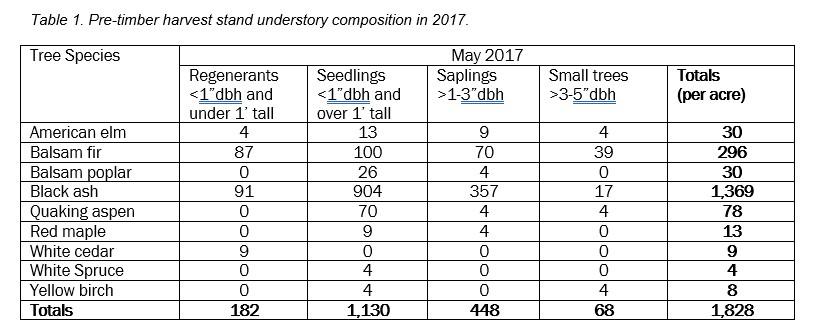
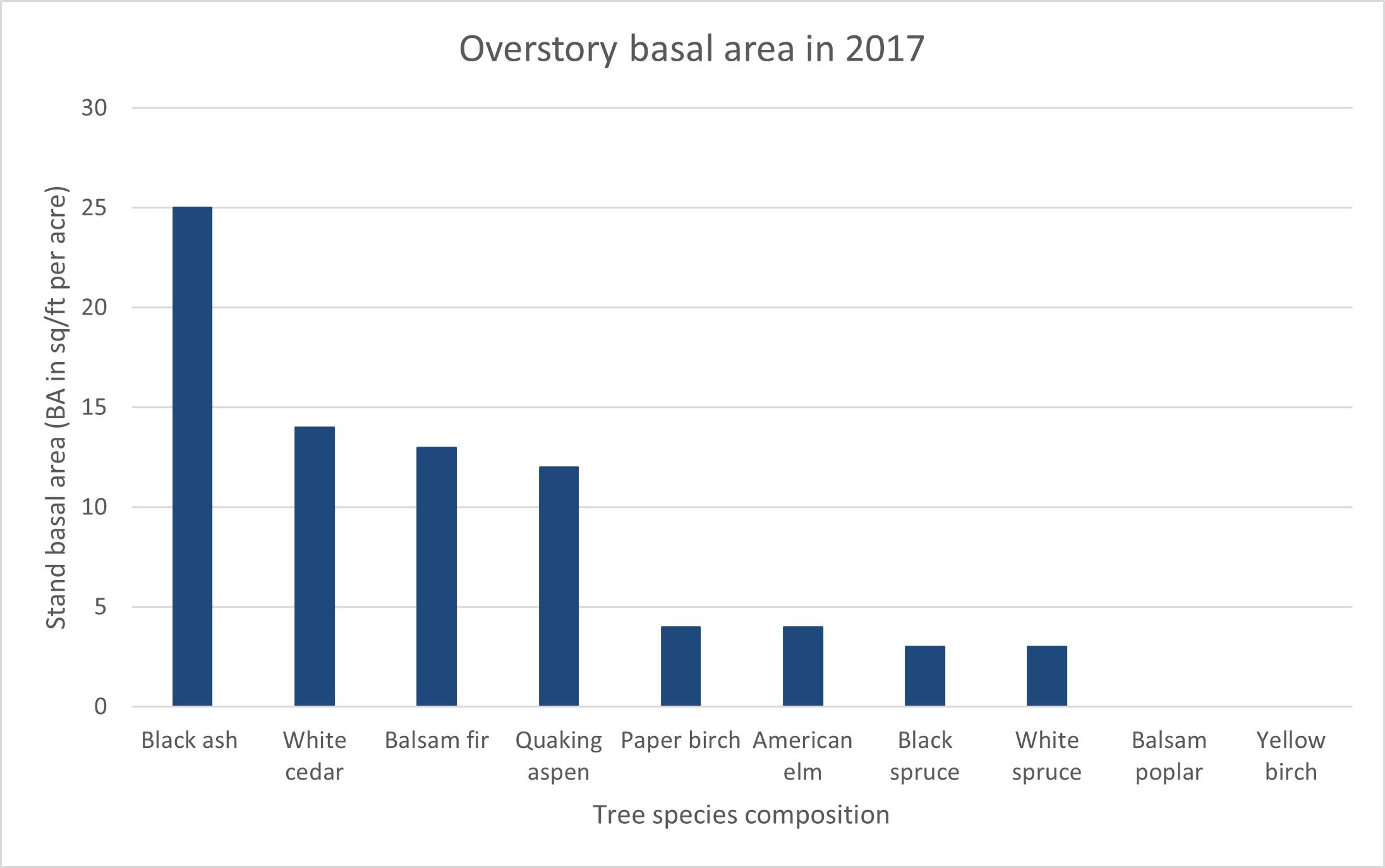
Figure 1: Overstory basal area in 2017.
Pre-treatment growth and stocking:
Past and future growth potential of commercial tree species in this stand is good for timber production. A site index of 52 for black ash is considered moderately productive. The stocking is average to slightly above average with a total volume of 21.4 cords/acre pre-timber harvest. With at least 8 different tree species growing productively on this site, a future forest of a similar or higher productivity and stocking should be possible. The site hydrology appears to be altered due to the railroad tracks to the north and road ditching to the west resulting is slightly drier soil conditions and improved soil drainage compared to other ash stands in the area. These local site factors affecting site hydrology appear to positively influence growth and stocking and should continue to be steady influences into the future.
Pre-treatment forest health issues:
Deer browse on brush and seedlings poses a threat to future regeneration without protection as seedlings may have a tougher time getting above the height that deer browse. Overstory white cedar is present in the stand as thermal cover which may attract the deer population throughout the winter. This may also explain the increased deer browse pressure observed here.
EAB is not currently onsite although it is present 40 miles away in Duluth, MN. A purple EAB trap is found on the Kettle Lake Road monitored by the MN Department of Agriculture. EAB is moving closer to the site as it was just discovered in the city of Cloquet about 19 miles away.
Landowner objectives/situation:
With EAB beginning to expand into areas of the state with a significant amount of ash forest, the Division of Forestry has updated its Ash Management Guidelines with information and recommendations for land managers with the goal of maintaining and protecting ecosystem values associated with wet-mesic ash forests for long-term sustainable forest management including timber production, water quality, hydrology, soils, and wildlife habitat. We have used the guidelines to inform the management plan and reforestation decisions in this case study.
Silviculture Prescription
The regeneration harvest was designed to capture timber revenue and utilize the commercial tree species on site while protecting site hydrology and preparing the site for a diversification planting of non-ash species. Whole tree skidding of the trees during frozen ground conditions is prescribed to knock down brush and if possible, expose some soil in places where the planting of non-ash seedlings can occur. Some of logging slash was prescribed to be redistributed evenly across the site, scattered enough so that planting would still be feasible and excess slash could be piled and burned at the landing.
Black ash, quaking aspen, balsam fir, black spruce and paper birch were all designated as timber harvest removal species as they were considered high risk for mortality due to size and age. White cedar, American elm and white spruce were reserved along with smaller birch and balsam fir where possible to help maintain site hydrological functions. The reserve trees amount to about one-quarter of the stand being reserved by volume and stand density. This amount is believed to be sufficient to shade out grass establishment and prevent the stand from swamping out (e.g., reserve trees maintain water uptake to prevent a significant rise in the groundwater table).
Tree planting was scheduled for the following spring following timber harvest. The Ash Management Guidelines recommend a minimum site index of 45 for artificial regeneration. Sites with a site index less than 45 may not make good candidates for planted tree survival, growth, and recruitment.
A variety of replacement tree species are appropriate for the site due to the range of growing conditions present which also supports the need for a long-term case study. According to the Ash Management Guidelines a regeneration goal of at least 300 non-ash crop trees/ac with 75% stocking is desired at the one-year regeneration check. 100-200 non-ash crop tpa with 75% of plots free to grow for the 5-year check. And 50-100 non-ash crop tpa with 75% of plots free to grow at the 10 and 15-year standards checks.
What actually happened during the treatment
The site was harvested by Richards Logging in March and April 2018. Frozen ground conditions were still present, but the snow had melted down some so the whole tree skidding process used in harvest was successful at smashing down and clearing the brush and exposing some soil. The Richards Logging crew, a small local family logging near Cromwell, MN, was ideal for a prescription like this. They took advantage of cold mornings for work and were able to shut down operations when it became too warm. This helped maintain the frost and minimize compaction and damage to the soil. Some damage to the reserved white cedar trees occurred as the crew attempted to work around them to cut and remove the commercial species. Therefore, the crew was directed to leave a small amount of quaking aspen, paper birch, balsam fir, and spruce around the cedar areas to prevent further damage. The basal area after harvest was reduced from 78 to 19 sq/ft per acre (Figure 2).
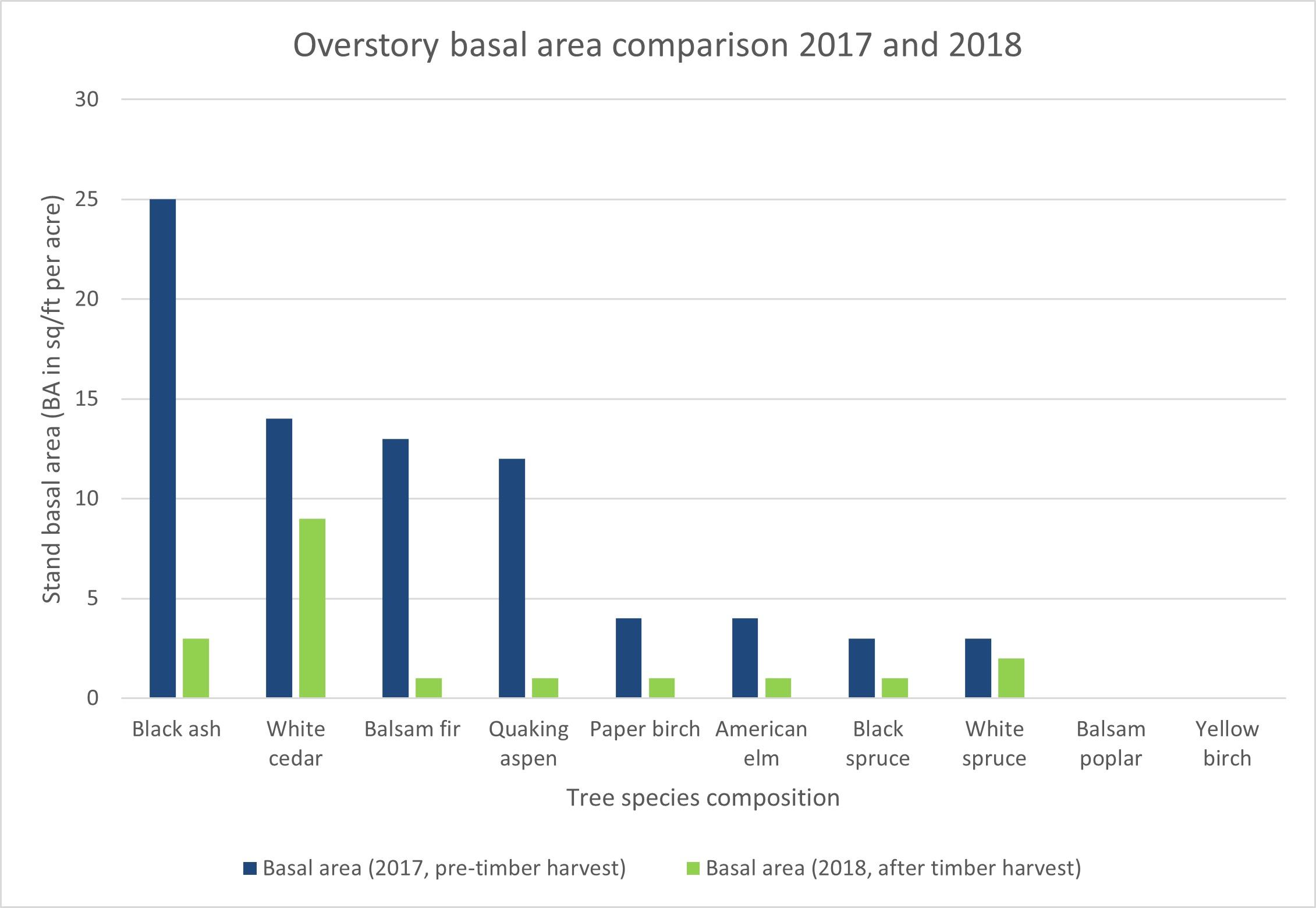
Figure 2: Overstory basal area comparison in 2017 and 2018.
12 non-ash replacement species were ordered from the State Forest Nursery. The nursery manager helped finalize the tree species order using available inventory and by procuring seedlings from other regional nurseries. Species ordered for planting included red maple, white spruce, black spruce, tamarack, hackberry, silver maple, balsam fir, paper birch, bur oak, swamp white oak, quaking aspen, and cottonwood. Yellow birch was not available. Planting of the site occurred May 2018. The original stocking planned for the planting was around 1000 seedlings per acre. However, another ash replacement planting project was cancelled as the timber harvest was not complete yet so most of the seedlings were used on this site instead. Planting density increased to 1,734 per acre. Spacing was adjusted to 5x5 ft.
The stand successfully regenerated after harvest with over 6,300 stems per acre (Table 2). Balsam fir, black spruce, bur oak, silver maple, and swamp white oak replacement species met acceptable stocking levels 6 months after tree planting.
Table 2: Regeneration survey comparison of understory composition in 2017 and 2018.
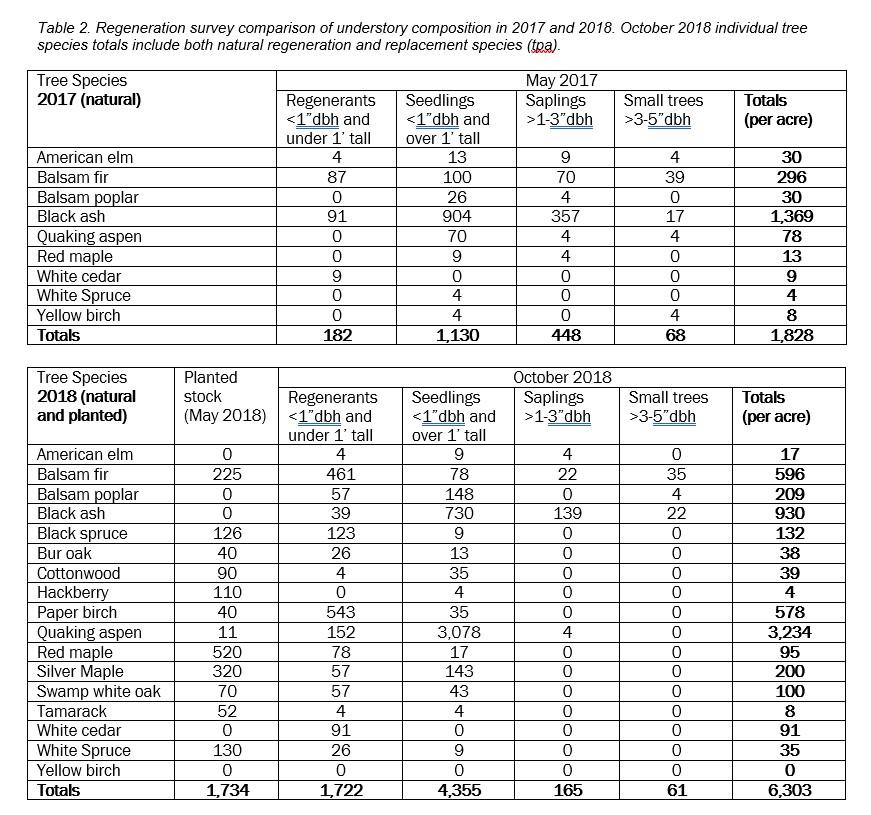
Post-treatment assessment
The original 23 timber cruise GPS points were established as permanent plots for the case study. Comparing the 2017 pre-harvest data with the most recent regeneration survey confirms the stand is regenerating to a more diverse forest (Table 3). Prior to harvest only 8 non-ash species were found in relatively low numbers (326 non-ash regenerants and seedlings per acre surveyed). In June 2021, 4 years after harvest, 13 species were found with 2,278 regenerants and seedlings per acre surveyed. The regeneration success cannot all be attributed to the planting as 1,069 of the 2,278 regenerants and seedlings are quaking aspen that sprouted vegetatively.
Table 3: Regeneration survey comparison of understory composition in 2018 and 2021.
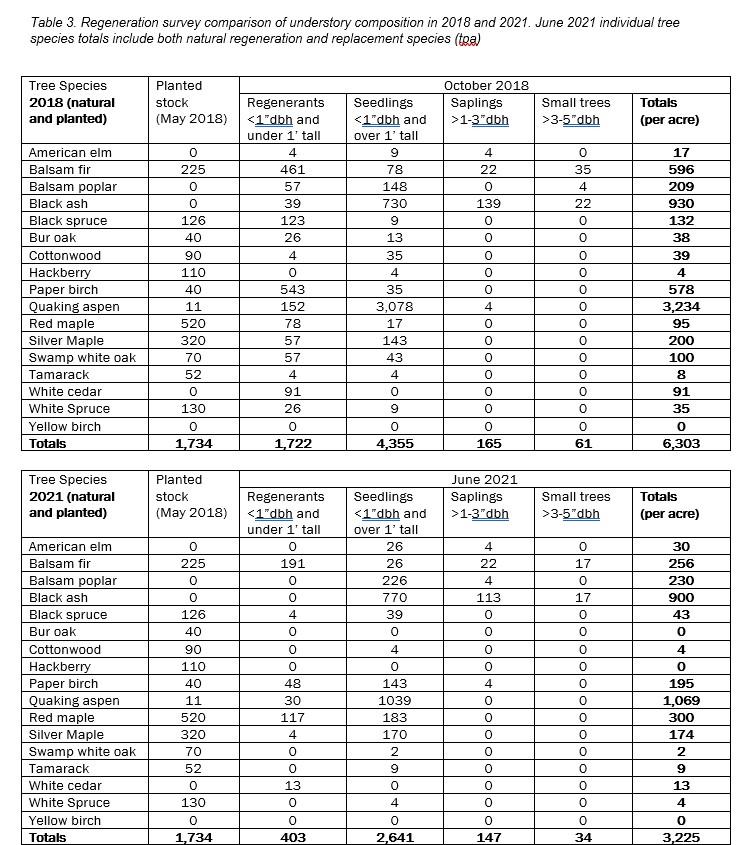
It is hopeful to see the establishment of non-ash planted species off to a decent start. However, it is difficult to separate the amount of regeneration that came from natural seeding/sprouting origin and the planting except for the introduced species that were not present prior to timber harvest. Either way the regeneration established confirms the desired future condition for a more diverse non ash forest. At this time, it seems likely the 5-year standard check goal of 100-200 non-ash crop tpa with 75% of plots free to grow will be met.
Species-Specific Observations
Quaking aspen root sprouting is tremendous with over 1,000 stems per acre at the 3-year survey check. Regenerants and seedlings represent over 1/3 of the total regeneration and are present on 43% of the regeneration survey plots.
Of all the planted species silver maple seems to stand out as being the most successful on this site (Figure 3). Seedlings are larger stock compared to other planted species, have survived a fair amount of deer browsing and have outpaced grass competition. The 3-year survey results confirm 170 tpa and a 53% survival rate. Since it has survived these first 3 years it may continue to grow well and get above deer browse height.
The red maple are of smaller planting stock compared to the silver maple and many of them were leafing out when planted. The regeneration surveys indicate either the planted seedlings are starting to grow, or a fair amount of natural red maple regeneration is occurring. The 3-year survey check confirms red maple regenerants and seedlings at 300 tpa. The red maple also have deer browse but have managed to survive, grow, and struggle through the competition.
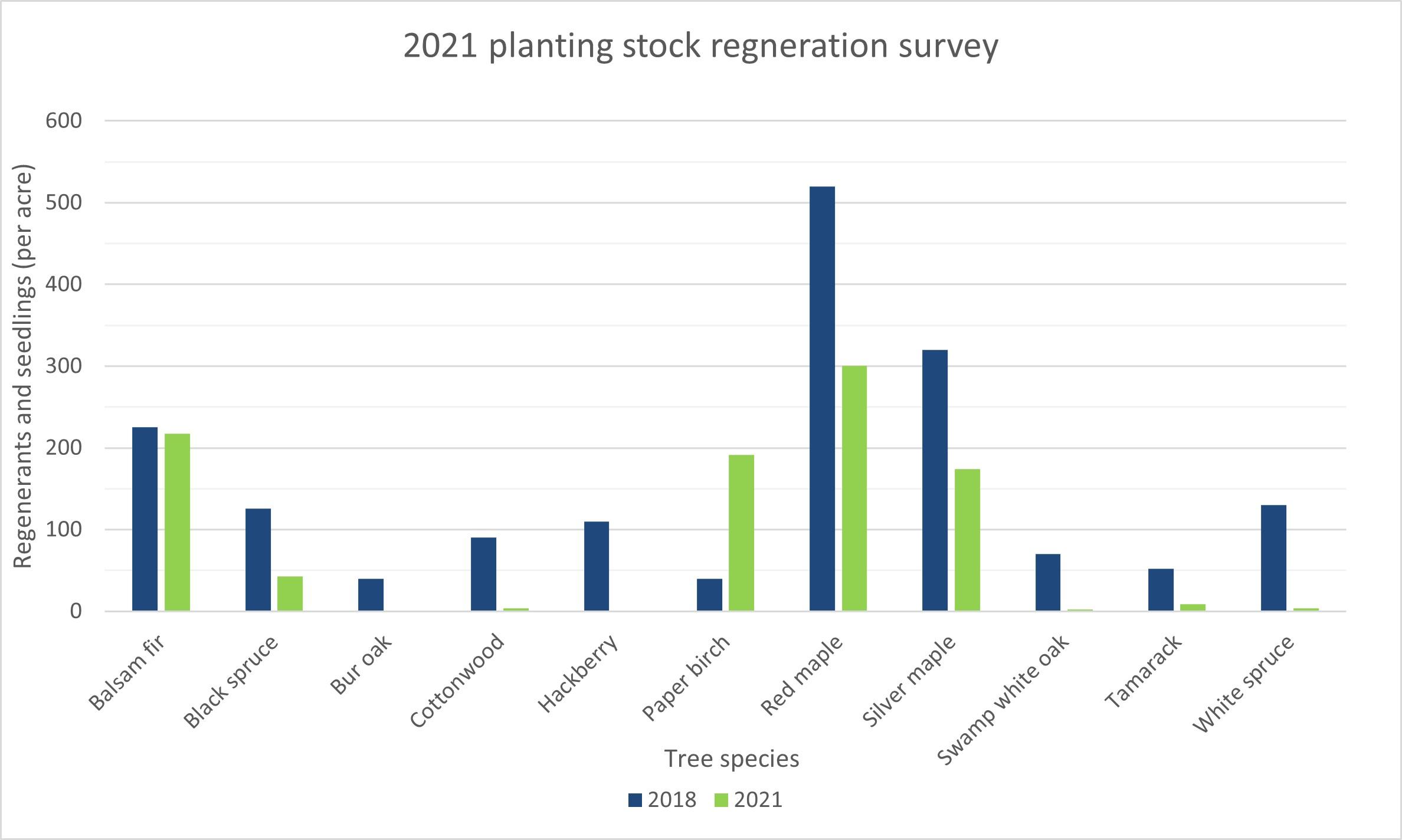
Figure 3: 2021 planting stock regeneration survey.
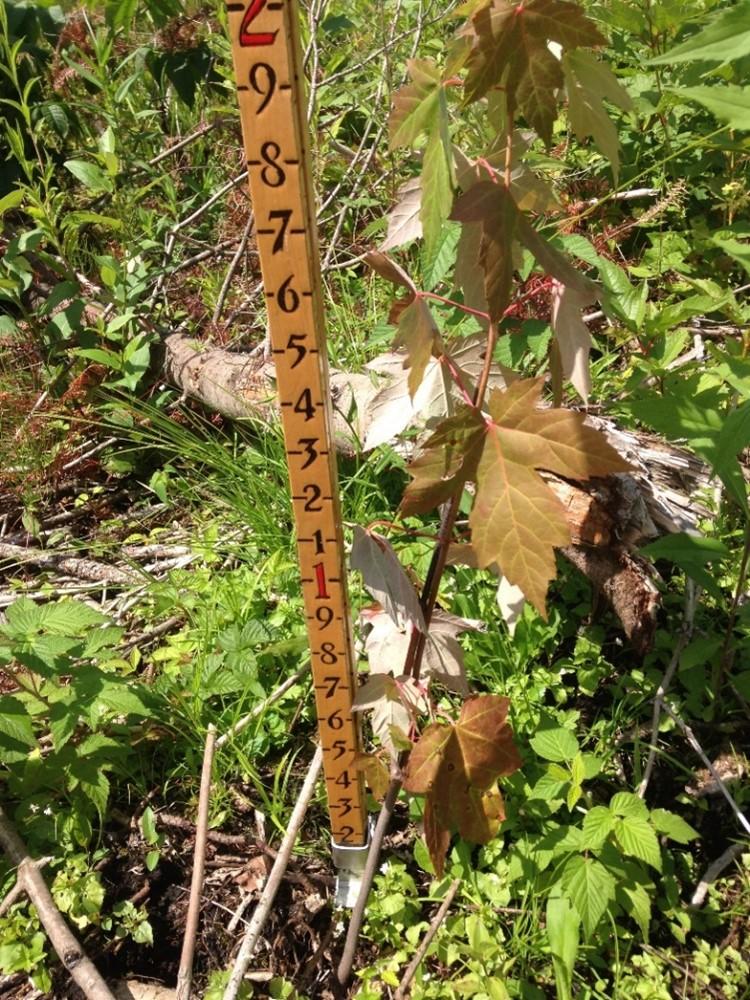
Figure 4: Planted silver maple in 2018.
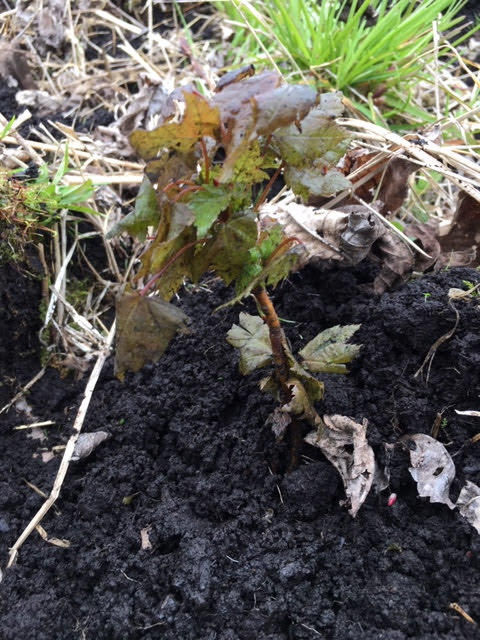
Figure 5: Red maple all leafed out at time of planting still surviving.
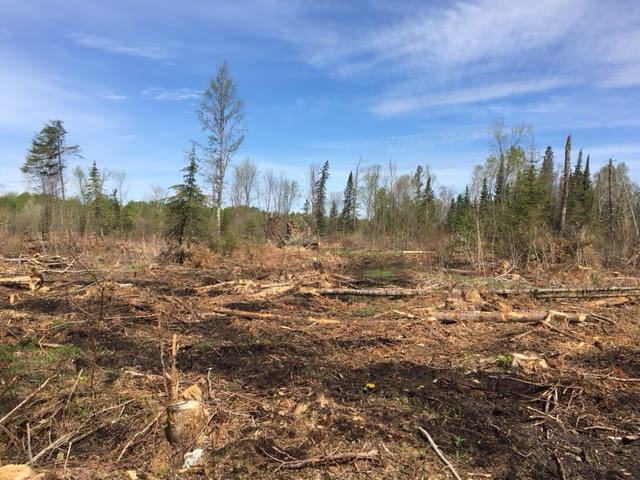
Figure 6: Ash site after timber harvest in 2018.
Paper birch is regenerating well and is most likely natural regeneration from seed. Most seedlings are found in mossy areas of the site where the seed germinated.
It is difficult to determine if cottonwood established. The regeneration surveys did not confirm any seedlings present. However, it is possible that cottonwood is very difficult to identify at this time and may have been recorded as quaking aspen. Our hope is we can find it in the future as the seedlings grow taller.
American elm seems to seed naturally in wet forest sites. The 3-year survey check confirms 30 tpa.
Bur oak and swamp white oak appeared to survive the initial planting but by the 3-year survey check have started to disappear. Deer browse is the likely culprit.
Hackberry is perhaps the biggest disappointment. After the initial planting it was difficult to find seedlings anywhere. There may have been an issue with the planting stock, it may be difficult to establish in wet forest conditions, or it may be hard to identify at this time. It also requires a process of “sweating the planting stock” to break dormancy. We suspect this was not done for the seedlings procured from the State Forest Nursery. We would be interested to learn results from others who have tried hackberry in their ash replacement plantings.
On this site black spruce is the conifer that appears to have the most promise. Seedlings are container plug stock which may be an unfair comparison with the other bare root stock. Most seedlings have survived despite the hare damage, have good growth, and look healthy.
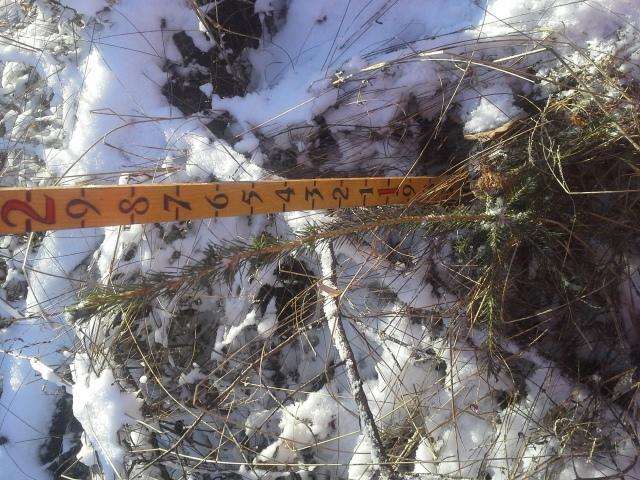
Figure 7: Black spruce doing well at November 2019 1 year check.
White spruce initially survived after planting but by the 3-year survey check have nearly disappeared. Hare damage is not present on the existing seedlings, but it is possible that seasonal water table fluctuation is an issue. Black spruce may have some advantage over white spruce in this regard.
Tamarack is growing well. Only a small amount was planted in a wetter, sunny, and open location to provide the best chance at survival. The regeneration survey data are not very representative of this fact.
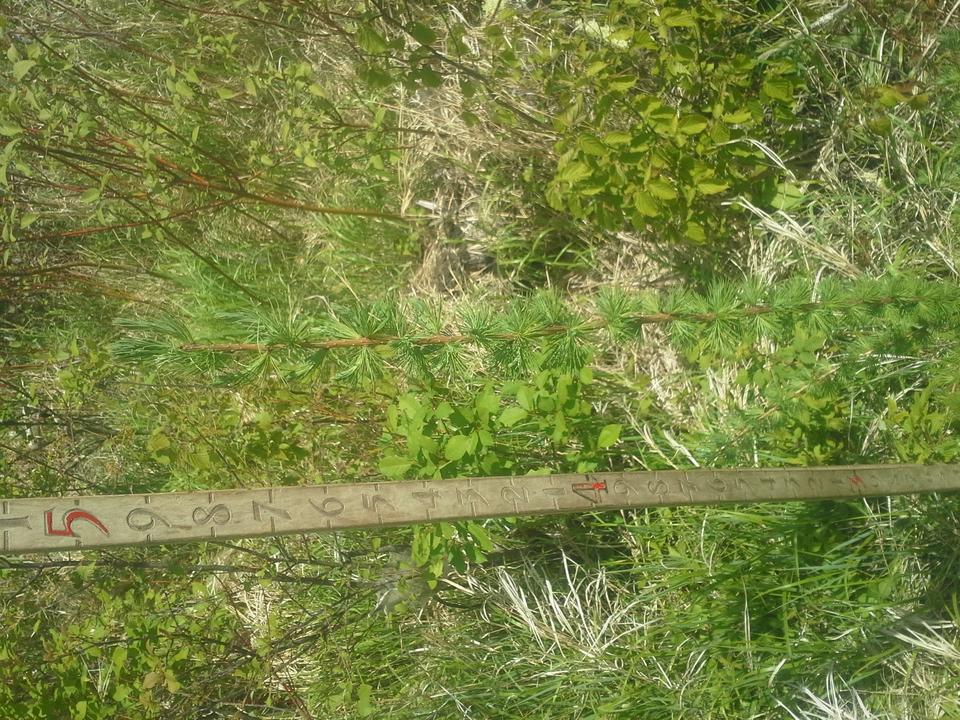
Figure 8: Tamarack with great growth, 5 feet at June 2021 3-year check.
Balsam fir regeneration and survival seems to be steady and similar to the pre timber harvest counts. Planting balsam fir did not have a noticeable impact.
A small amount of white cedar regenerants are present which is promising for natural regeneration but given the deer browse pressure it is doubtful that few, if any, will be able to survive and grow to seedling size.
Recommendations to increase natural regeneration
If merchantable quaking aspen is present or adjacent to the stand, we recommend harvesting nearly all trees to establish a new cohort of root suckers to quickly occupy the growing space and maintain hydrological function. American elm, balsam fir, white cedar and red maple trees can be prescribed as retention species to increase natural seeding and regeneration opportunities. For balsam fir reserve clumps of small diameter trees (2 sticks and smaller). It seems the only way to maintain white cedar in wet forest sites is to reserve as much of the mature trees as possible and arrange for frequent timber sale supervision to limit bole and root damage during timber felling and skidding.
Plans for future treatments
There are no plans for future treatment needs currently.
This case study will be updated in the summer of 2024 with analyis of the data collected at the 5-year regeneration check scheduled for the fall of 2023.
Then this case study will be updated in the summer of 2029 with analyis of the data collected at the 10-year regeneration check scheduled for the fall of 2028.
Costs and economic considerations
The total revenue generated from the timber harvest is $5,553.52 removing 360 cords of balsam poplar (balm of gilead), black ash, balsam fir, paper birch, quaking aspen, and black spruce. White cedar, American elm and white spruce reserved from harvest (Table 4).
Table 4: Timber revenue.
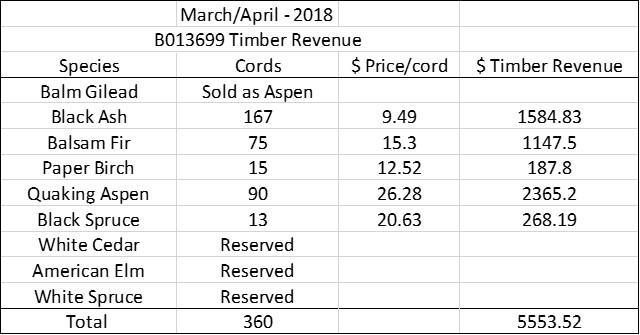
The cost of a multi-species tree planting trail in a wet forest system is expensive, but a worthy investment to ensure we have the opportunity to learn more about non-ash replacement species survival and growth. The impact on ash forests due to EAB may also prove to be expensive resulting in cultural, economic, environmental, and wildlife habitat consequences which are largely unknown in the region at this time. It our wish that information and recommendations from this case study help forestry professionals and landowners make informed ash management and reforestation decisions to ensure the best outcome for the future forest while considering the high costs of artificial regeneration with bareroot and container planting stock.
Other notes
We thank Stephanie Patton and Brian Anderson with the University of Minnesota Department of Forest Resources for contributing field data collection and plot monumentation.
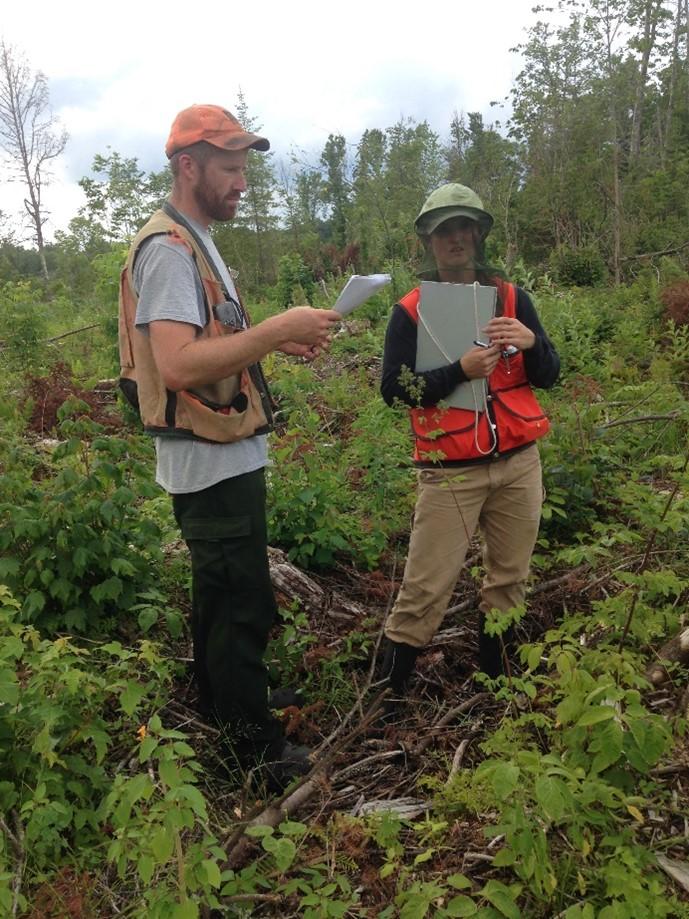
Figure 9: Wes Habedank and Stephanie Patton in the field.
The author thanks Paul Dubuque and Mike Reinikainen with the MN DNR for case study review and editing assistance.
Climate Adaptation Considerations
This is one of the first wet forest climate adaptive, “assisted migration” projects initiated by the Division of Forestry. We decided to incorporate a few species we believe have the possibility to grow well on this site but are not currently present in the WFn55 plant community or this far north in Minnesota. Hackberry, cottonwood, swamp white oak, and silver maple were procured from seed zones in central or southern Minnesota to assess the feasibility of their survival and growth, and to evaluate if they will provide unique or worthwhile economic and ecological advantages when compared to the similar species present in wet forest systems. Most of the species have good adaptability and capability ratings and are generally expected to maintain or increase in future suitable habitat according to the Northern Institute of Applied Climate Science Climate Change Predictions for Individual Tree Species in the Northern Minnesota Drift and Lake Plains Ecological Section.
Hackberry was included as it is found to be tolerant of a variety of soil conditions including wet soils in the bottomlands along rivers in southern Minnesota and elsewhere. The appearance, growth and form somewhat resembles the black ash tree. It may be economically and aesthetically appropriate to have a tree that looks similar to black ash and that may have a similar market opportunity in the future.
Cottonwood usually thrives in soil conditions that are frequently wet and usually tolerates some period of water inundation. We are interested in observing how the survival and growth compares with quaking aspen and balsam poplar on the site. It is also interesting to know if this species can establish and regenerate given the large amount of cotton-like seed produced as early as 5-10 years old. This life trait strategy may be advantageous in helping reforest wet forest sites by filling in the gaps where ash trees have died due to temporary flooding or EAB attack. Cottonwood may also have a positive role in working to maintain hydrological function as it may be able to pump a lot of water to assist in preventing wet forest sites from swamping. It is a species that grows fast and of large diameter.
Swamp white oak was chosen to see if it has any advantages over bur oak. According to recent studies, swamp white oak, similar to black ash, has adapted to grow in low oxygen soil conditions to survive in poorly drained soils and appears to survive and grow well in a research project in the region (refer to the Silviculture Library case study looking at EAB treatments on the Chippewa NF).
Although already present in northern Minnesota, silver maple is very rarely found in wet forest plant communities that are located away from the river and stream banks where it is most commonly found in floodplain forest plant communities. It can regenerate well as stump sprouts, is a prolific seed producer, grows quickly, and continues to be a valuable species for the future as the market for maple pulp remains steady at the nearby Sappi paper mill.
Summary / lessons learned / additional thoughts
Early case study results suggest silver maple and red maple bareroot stock and black spruce container plugs as very good options for tree planting. Tamarack may be an additional species to try on wetter sites or with deeper peat soils. Clearcut sites that result in open like conditions with full sunlight may also be a good option for tamarack, especially if non-ash hardwoods are not present. Using balsam poplar cuttings shows promise as a cheaper tree planting alternative but stock was not available for this case study.
We recommend prescriptions and timber sale design that maximizes the natural regeneration potential of quaking aspen, paper birch, yellow birch, red maple, American elm, balsam fir or other desirable species present on the site. Reserve well-formed and large crowned paper birch, American elm and red maple seed trees in clumps or patches. Reserve as many smaller balsam fir tree clumps as possible. These clumps will have a better chance to withstand windthrow and can provide adequate seed for natural regeneration. Reserve and protect white cedar for similar reasons. Clumping reserves around the white cedar helps protect from logging equipment damage to the tree boles or root systems and will help maintain windfirmness for all the reserves. On wetter ash sites (WFn64) it is especially important to reserve small diameter ash or of ash in strips and clumps. The ash retention will help hydrological function while the regenerating site re-establishes.
In the future non-ash replacement tree plantings with multiple species may not be necessary as foresters’ knowledge and understanding for which species survive and grow best in wet forests is expanding every year. However, we continue to collaborate on ash replacement trials with the American Bird Conservancy, Leech Lake Band of Ojibwe and other landowners who recognize the importance of maintaining ash sites as forested habitat while also increasing diversity and climate resiliency prior to widespread EAB outbreaks.
